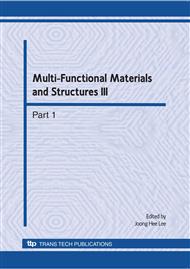p.1131
p.1135
p.1139
p.1143
p.1147
p.1151
p.1155
p.1159
p.1163
Experimental Evaluation for Mechanical Property of Unidirectional Banana Reinforced Polyester Composites
Abstract:
Development of composite materials requires reinforcement and matrix in which fiber is finest suitable material for reinforcement which improves properties of materials. The use of high strength fiber leads to birth of advanced composites, which are mainly used, for high strength application or aerospace application. However, the use of medium strength and low strength fiber available in nature are also having enough potential for other application where high strength are not critical but it can provide a feasible range of alternative materials to suitable conventional material. Several billion tons of fillers and reinforcements are used annually in the plastics industry, and there is a huge potential market for recyclable, energy efficient and more environmentally friendly composite materials. The present work examines the different types of natural fiber available for the development potential composites. The attempts are already made for jute, flax and sisal natural fibers provides data from literature but there is lack of experimental data availability for unidirectional natural fiber composite like cotton, pineapple, banana fiber reinforced unidirectional composite. It is decided to carry out the systematic experimental study for the effect of volume fraction of reinforcement on longitudinal strength as well as elastic modulus using developed mould-punch set up and testing aids. The testing is carried out as per ASTM D3039/3039M-08. Specimen failure inspection was carried out through Scanning Electron Microscope (Model: Hitachi S-3400N). The comparative assessment of obtained experimental results with predictive models forms an equally important constituent of present work.
Info:
Periodical:
Pages:
1147-1150
Citation:
Online since:
August 2010
Authors:
Price:
Сopyright:
© 2010 Trans Tech Publications Ltd. All Rights Reserved
Share:
Citation:


